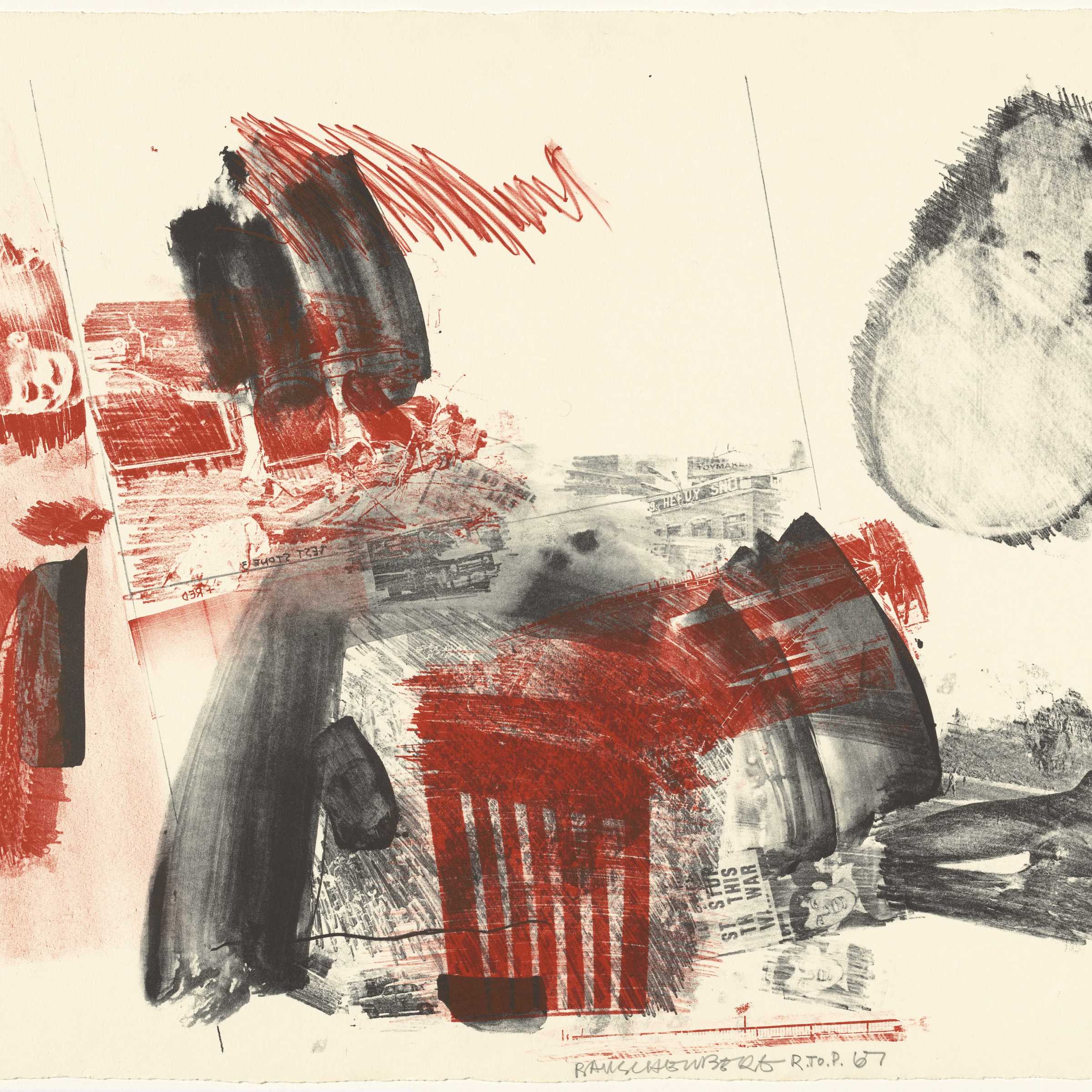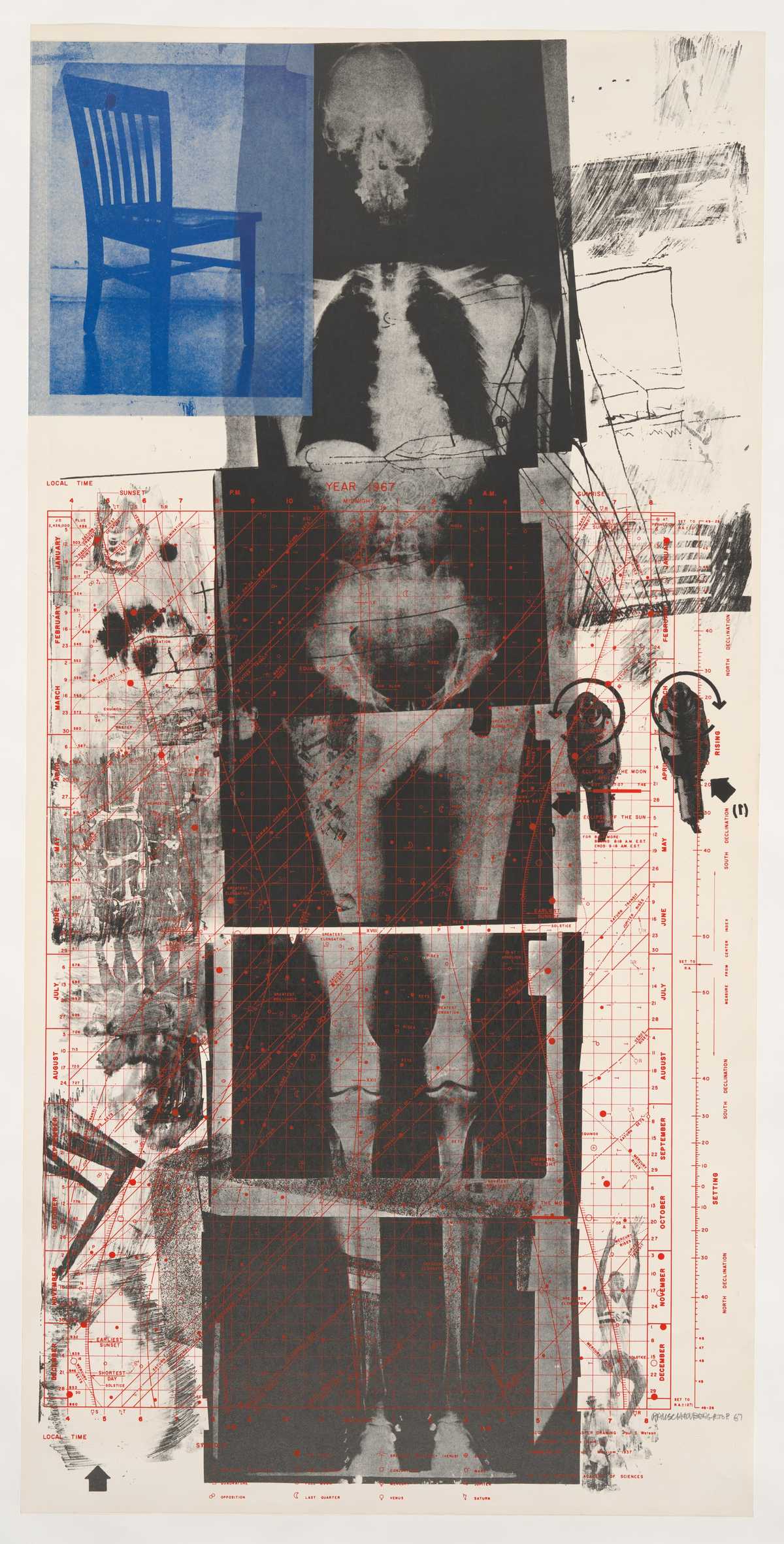
Robert Rauschenberg, Booster 1967 from Booster and 7 studies series, colour lithograph, screenprint, 183 x 89 cm, published by Gemini Graphic Editions Limited, Los Angeles. National Gallery of Australia, Kamberri/Canberra, purchased 1973. © Robert Rauschenberg / Copyright Agency, 2022
‘I’m thinking of doing a self-portrait of inner man’,1 Robert Rauschenberg announced when he arrived at Gemini GEL print studio to work with master printmaker Kenneth Tyler. For an artist who regularly denied the presence of biographical traces in his work, this clear intent to create a self-portrait is significant. The self-portrait that he was to produce, Booster 1967, would cause a stir as the largest hand-pulled lithograph ever made at the time,2 at a little over six feet [183 cm] tall. Central to the work is Rauschenberg’s X-rayed body, fragmented into six segments. This index of the artist’s body has scientific or medical connotations and is confronting in the way technological images of a sick person or dead body might be. Surrounding this central motif are numerous seemingly unrelated images: sports photographs, two drills, a chair and other more obscured pictures. Overlaid over the entire composition is a moon and planetary map drawn in red, tracking the movement of heavenly bodies for the year 1967. The overall impression is that this work could be about technology, the human body, and the Cold War obsession with space exploration.
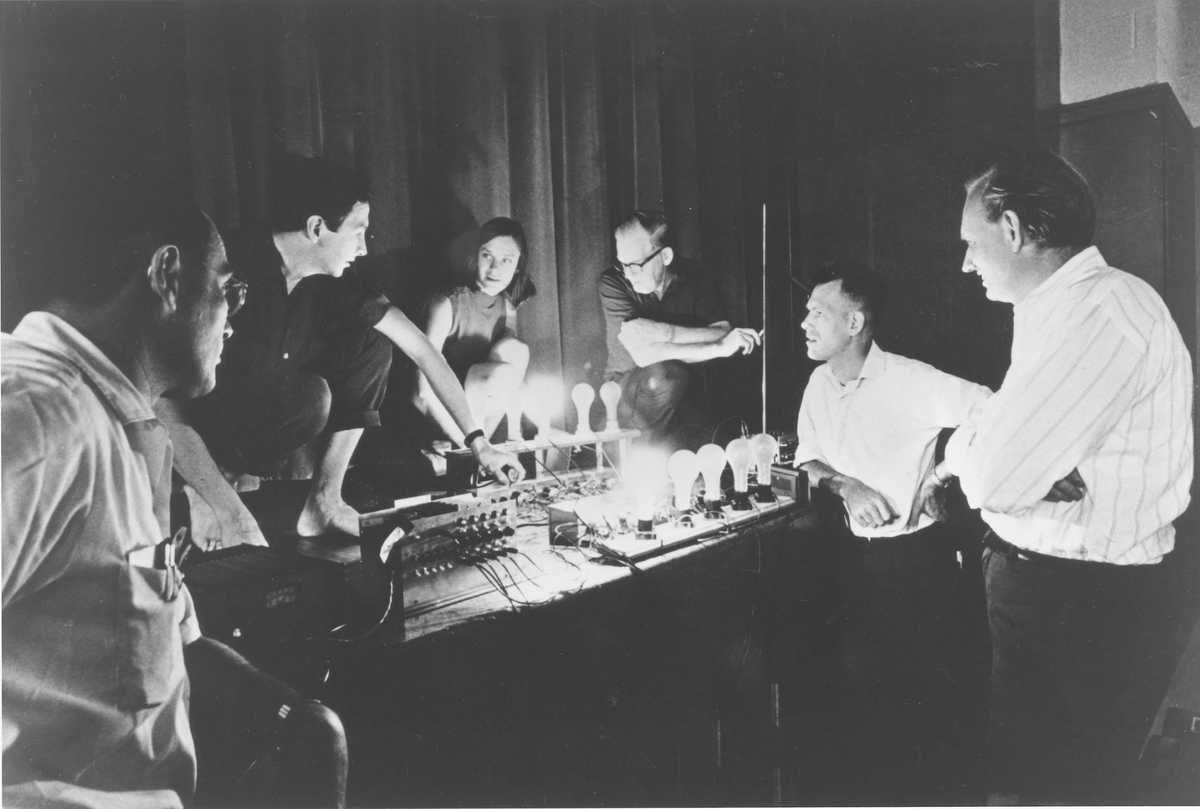
From left: Herb Schneider, Robert Rauschenberg, Lucinda Childs, LJ Robinson, Per Biorn and Billy Klüver at a technical rehearsal for 9 Evenings 1966. Image courtesy Robert Rauschenberg Foundation
Indeed, Rauschenberg’s upright skeletal structure could resemble a rocket booster and explain the title—Booster is often interpreted in this way.3 Rauschenberg had a growing interest in technology and had dedicated a large part of his practice in the 1960s to incorporating electronic and mechanical components into his artworks. Working with the Bell Telephone lab technician Billy Klüver, Rauschenberg had established the organisation Experiments in Art and Technology (E.A.T.) and together they would produce interactive artworks that reacted to a viewer’s presence, such as Oracle 1965 and Soundings 1968. Rauschenberg had also developed a growing interest in the quickly growing Apollo space program, creating works such as Untitled (for astronaut White) 1965, a collage made in response to the first American space walk by Edward White.
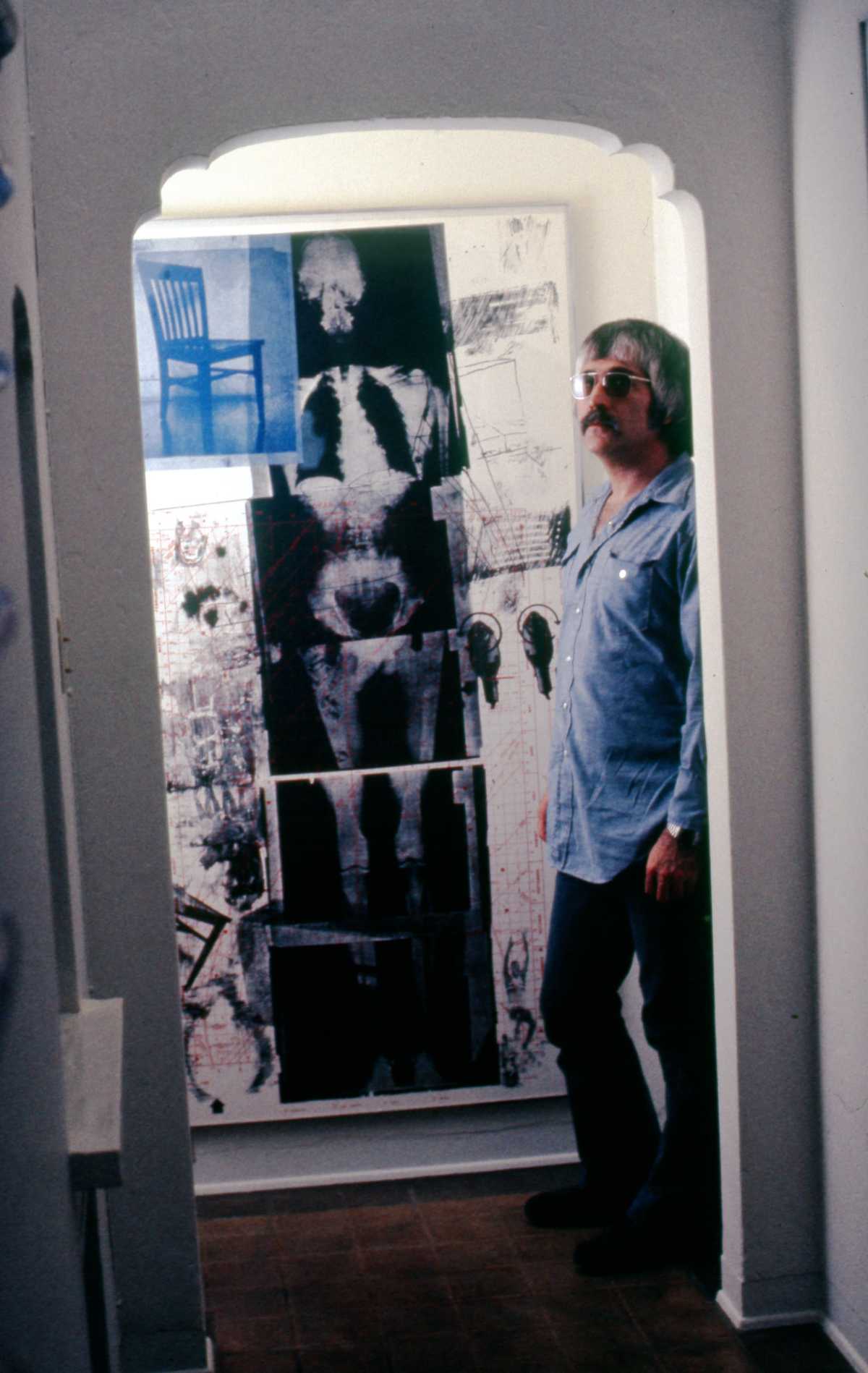
Kenneth Tyler stands in his Los Angeles home next to Robert Rauschenberg's Booster, 1973. Kenneth E Tyler Collection archive, NGA Study Collection © photographer, Sid Avery
But what if the meaning behind this work was not technological but instead was personal? If we accept that Booster is a self-portrait, we can read the work in relation to biographical accounts of the artist’s life. In 1962, an ambitious young printmaker named Kenneth Tyler had begun his role as the artistic director of Tamarind Lithography, a Los Angeles–based training institution that sought to revive the disappearing art of printmaking in America. Up until that time printmaking had been bound to restrictive conventions, and Tyler immediately saw the opportunity to push the medium to new heights. He established his own workshop, Gemini Graphic Editions Limited (Gemini GEL) in 1966, so that he could more purposefully pursue his vision to engineer creative solutions and expand the world of printmaking. Gemini GEL was run on a simple philosophy: where printmaking would once have confined an artist’s ambition to the known limits of the craft, Tyler would seek the best artists and encourage them ‘to make demands on the medium’.4
In 1966, Tyler approached the New York gallerist Leo Castelli, who represented both Jasper Johns and Robert Rauschenberg, and Castelli recommended that Tyler begin working with Rauschenberg. The late 1960s ‘was not a good time for Rauschenberg … personally or professionally’,5 according to Rauschenberg’s biographer Calvin Tomkins, because his work was not selling well, he had been drinking heavily and in 1966 had split with his partner Steve Paxton, a dancer and choreographer with the Judson Street Theater.6 Kenneth Tyler made his way to New York, where, as he said, ‘Leo arranged for me to meet with Bob, so I went to Lafayette Street, to the brownstone, and I met with Bob and somehow, we hit it off with a lot of laughter and lot of drinking’.7 Rauschenberg agreed to work with Tyler and the art that they went on to produce would change printmaking history. The artist’s outgoing presence heightened the collaborative atmosphere of the workshop, as Tyler recalled:
Rauschenberg is absolutely a master. I’ve talked with printers who’ve worked with Picasso, Miro, you name them—but their collaboration was very simple compared with Rauschenberg’s. Work with him and you get his life, spirit, energy: he’s the only two-way street in the art world.8
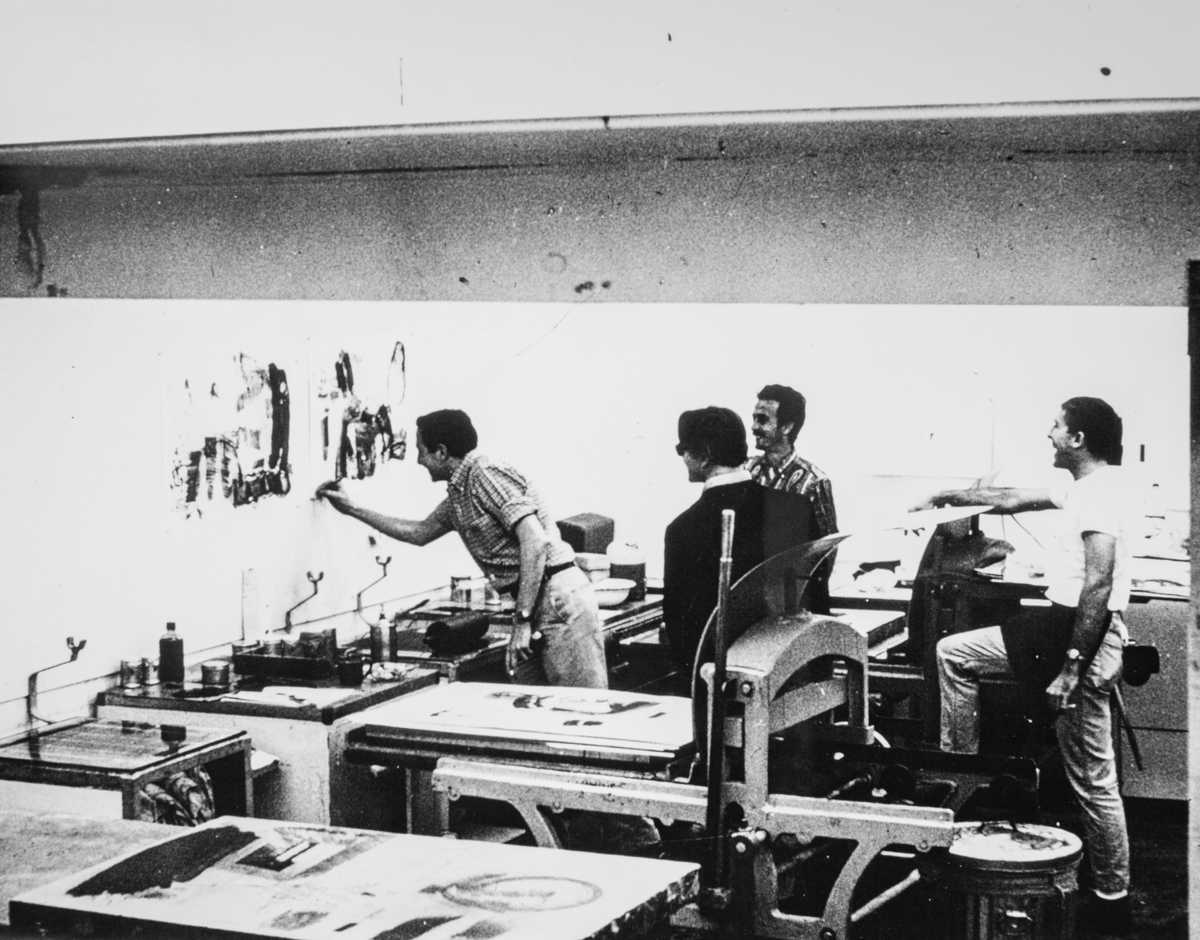
Robert Rauschenberg and printers at Gemini GEL during the production of the series Booster and 7 studies 1967. Kenneth E Tyler Collection archive, NGA Study Collection
X-rays
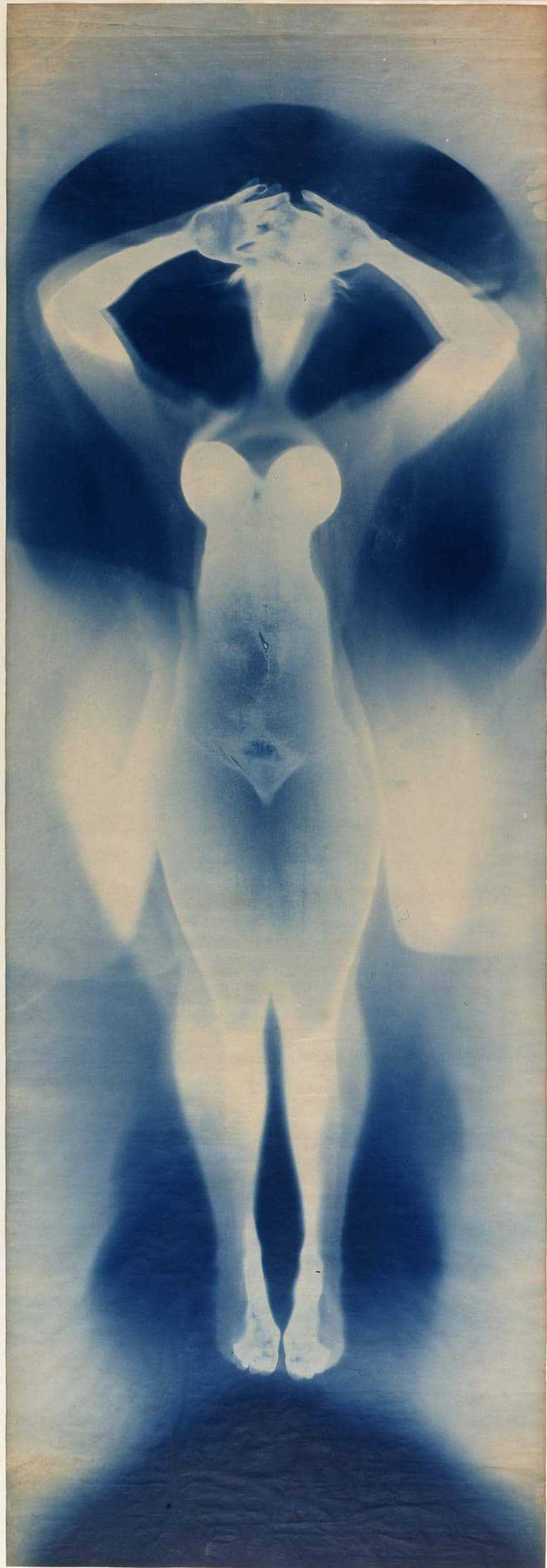
Robert Rauschenberg and Susan Weil, Female Figure c 1950, cyanotype, 265.7 x 91.1 cm. Collection of Robert Rauschenberg Foundation, Acc# 49.E001. Image courtesy Robert Rauschenberg Foundation. © Robert Rauschenberg / Copyright Agency, 2022 and © Susan Weil, 2022
Robert Rauschenberg produced his first life-size images of the human body in the 1950s while creating works with his wife at that time, Susan Weil. In late 1949, Weil had introduced Rauschenberg to working with photosensitive blueprint paper. She would place objects on its surface and then expose the paper with a handheld sunlamp. Wherever the light fell the paper would turn a brilliant blue, but the paper would remain colourless in the places where the objects had touched the surface and show gradations of blue where they had cast shadows. Rauschenberg and Weil would use their friends and their own bodies to make indexical impressions, such as the work Female Figure c 1950.

Rauschenberg’s X-rays used in Booster, hanging on a wall. Image courtesy Robert Rauschenberg Foundation
Booster recalls these life-size photographically exposed bodies. Standing naked except for a pair of hobnail boots, Rauschenberg had his body X-rayed in segments from head to toe at a Kaiser medical facility. X-rays had been a familiar part of Rauschenberg’s early adulthood, when he worked on medical wards during the Second World War. Rauschenberg had been responsible for bathing the bodies of recently deceased tuberculosis patients before burial. This close experience of death may lead us to read Booster’s X-ray as a memento mori, as a reminder of the fragility of life. However, Rauschenberg is clear that the ‘occasional skull [in his work] doesn’t necessarily mean death’.9 This X-ray may instead signify his psychological self-examination. Rauschenberg had previously drawn on medical language to describe the act of introspection, in this account for his origins as an artist, for example: ‘I sat in the coffee shop, embalmed in coffee, and did an autopsy on myself … Otherwise I probably wouldn’t have become an artist’.10
Using this same language in visual form, Booster uses the X-ray to look beyond the exterior of the artist to an ‘inner man’. Significantly, the same X-ray would reappear in his work Autobiography 1968, and here the swirling text detailing his life to date makes explicit the work’s purpose as the site of biography of the self.
Sport
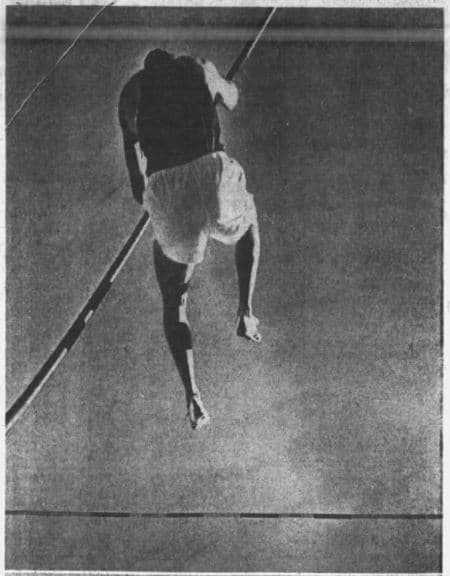
Newspaper clipping, Los Angeles Times, 8 February 1967. Image courtesy newspapers.com
Surrounding the X-ray is a series of newspaper clippings from the Los Angeles Times. Rauschenberg took these images, which are kept for only a short time in what are known as ‘photo morgues’, from the metal photoengraving plates used to print the newspaper. There is a time-lapse photograph of the baseball pitcher Sandy Koufax swinging a golf club at an amateur tournament. In the bottom right corner is an image of the early 1960s world- record holder Ralph Boston competing in the long jump. A sequence of four photographs runs down the side of the work from top right, showing pole vaulter Bob Seagren in action.

Newspaper clipping, Los Angeles Times, 2 February 1967. Image courtesy newspapers.com
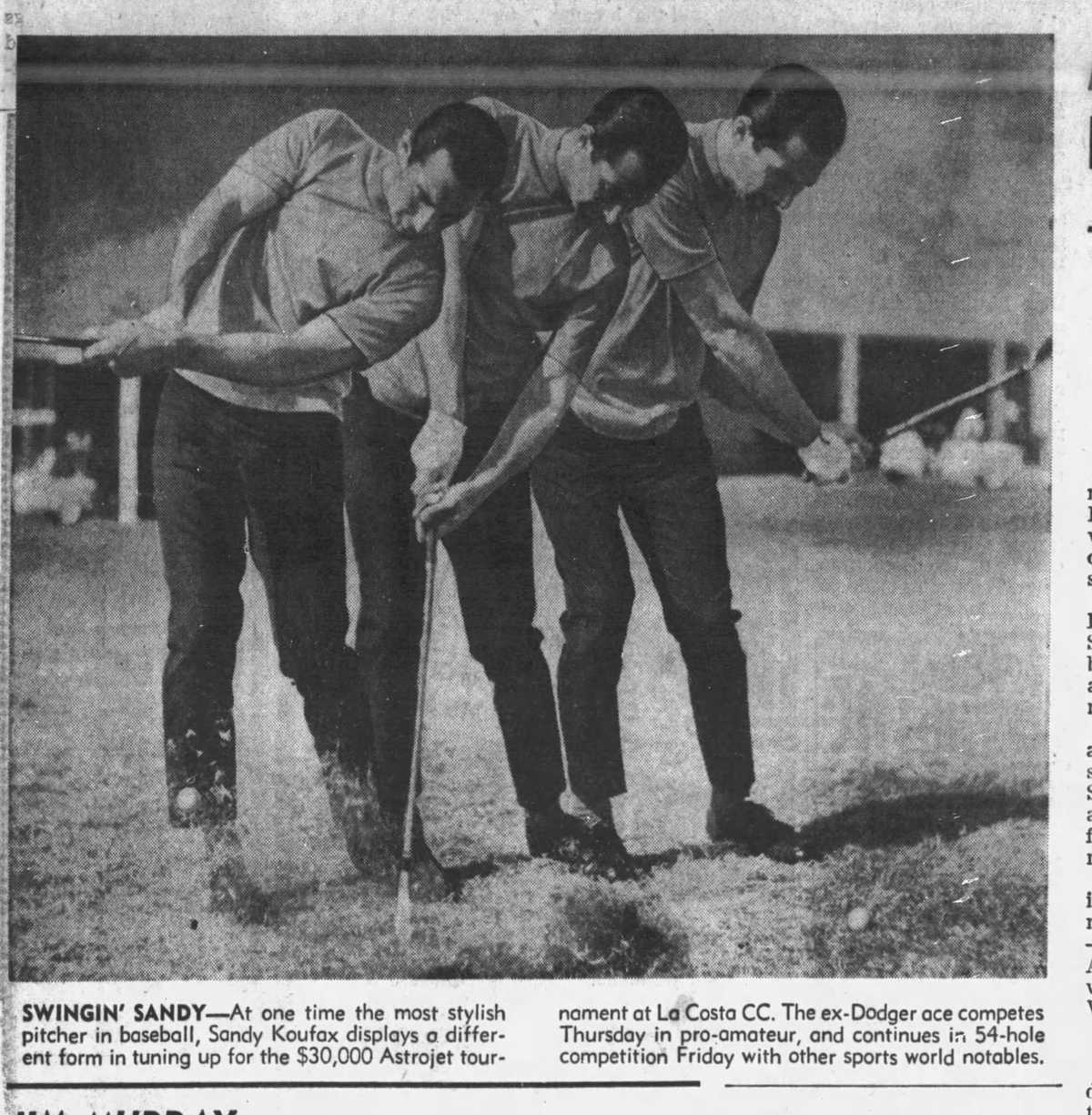
Newspaper clipping, Los Angeles Times, 8 February 1967. Image courtesy newspapers.com
These images of athletes may reflect Rauschenberg’s enduring fascination with the human body in movement. Since 1954 he had worked with dancers at both the Merce Cunningham Dance company and the Judson Street Theater, designing sets, costumes and occasionally the choreography. But whether these images of athletes carry significance for the artist is uncertain: Rauschenberg would often speak of the need for images in his work that would ‘dull the social implications, to neutralise the calamities that were going on in the outside world’,11 and would instruct his studio assistants to source ‘dumb’ images, or pictures that don’t support a simple narrative.12 In 1962 the art critic Brian O’Doherty witnessed Rauschenberg’s selecting such images at the New York Times photo morgue. Rauschenberg described ‘avoid[ing] his own taste … I like images to be as general looking as possible’.13
Power tools
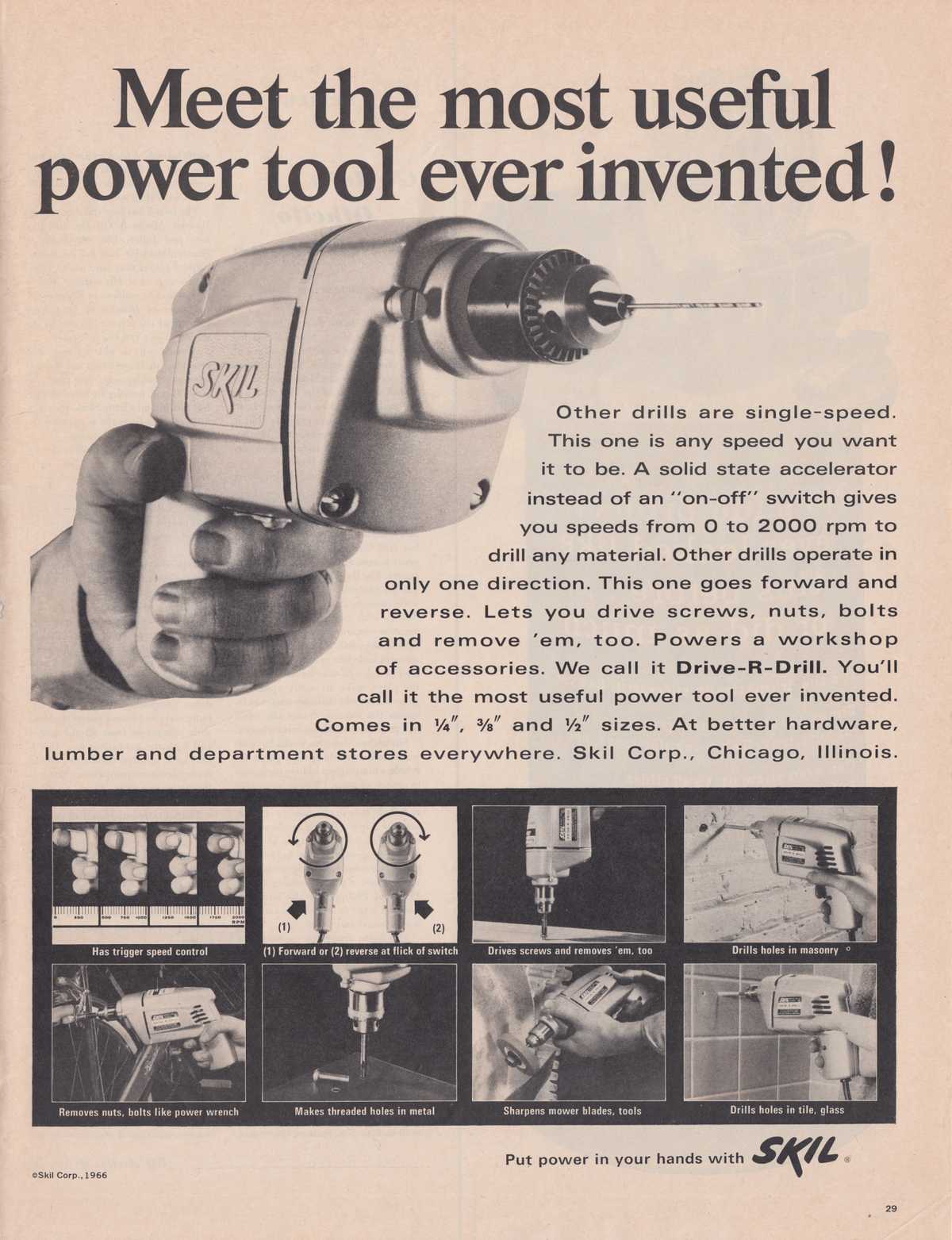
Advertisement for SKIL Drive-R-Drill from Life, 25 November 1966
On the right-hand side of the composition are two drills with directional arrows. The frequent reading of Booster as an artwork concerned with space-race technology has led writers to label these as ‘a pair of jet engines’,14 but a more compelling account is that Rauschenberg saw these drills as code for body parts: reproduced from an advertisement for the Skil Corp Drive-R-Drill electric drill, the drills appear in proximity to Rauschenberg’s pelvis, giving them sexual connotations. While Rauschenberg didn’t include the original advertisement’s eye-catching heading—‘Meet the most useful power tool ever invented!’—he likely included the drills because of their clearly phallic association. Indeed, the drills draw our attention to what the X-ray has inadvertently picked up: the artist’s penis. Kenneth Tyler recalls that when the X-rays arrived at the studio, Rauschenberg ‘was thrilled to death that both his hobnail shoes and his penis were in the X-ray’15 and would ask the print staff to ensure this detail was not lost in the printing process.16 The small section of the advertisement that was chosen by Rauschenberg advertises the drill’s ability to move forwards and reverse at the flick of a switch, a choice that reinforces the humorous sexual connotations.
Empty chairs
In the top left-hand corner of Booster is a reproduction of a polaroid photograph of a blue chair. It is possible that Rauschenberg is alluding to Joseph Kosuth’s conceptual work One and three chairs 1964, signalling that work’s play between objects, language and ideas. Is this chair simply a chair? Rauschenberg elevates this everyday object to the status of an art object, like one of Marcel Duchamp’s readymades. He used multiple photographs of this chair in his interactive Soundings 1968, and it featured on the exhibition poster when the installation was exhibited at New York’s Museum of Modern Art in 1968‒69.
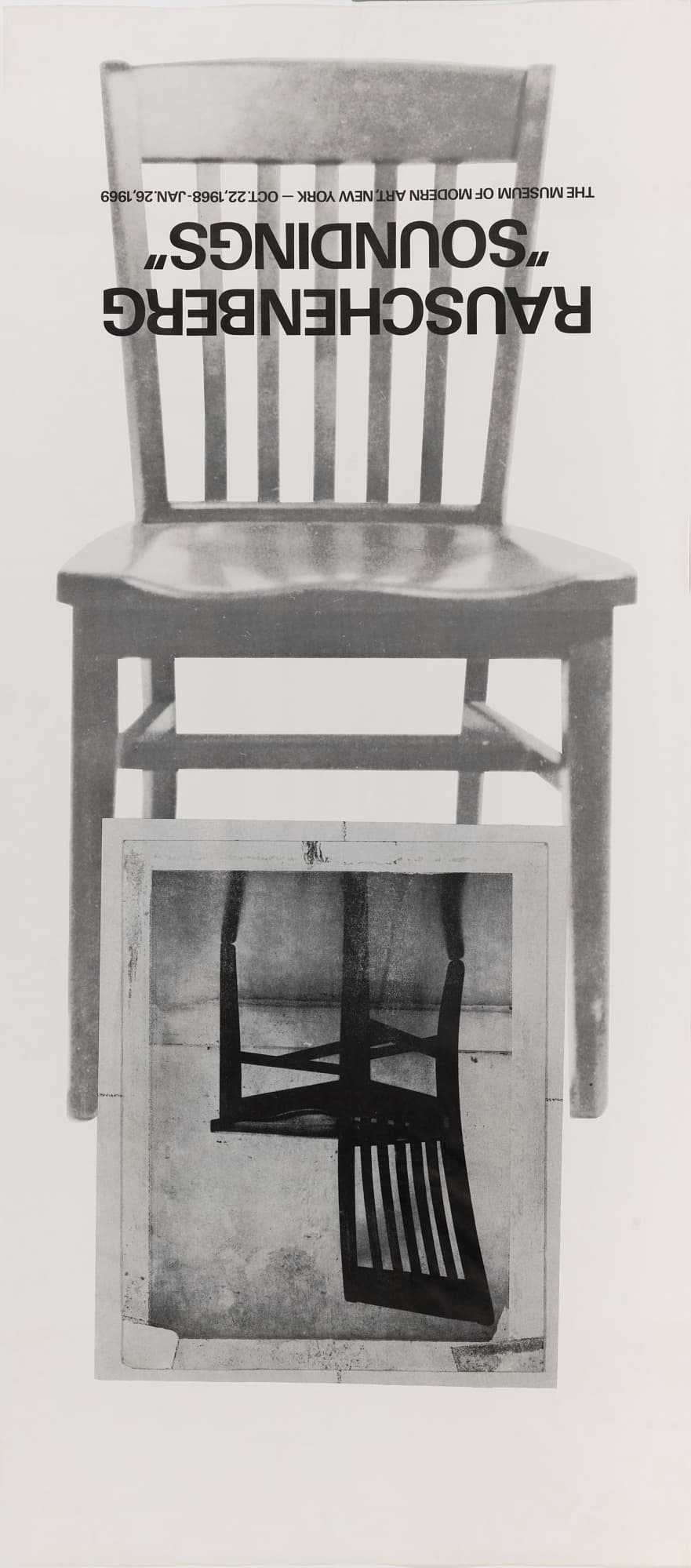
Poster for Rauschenberg’s exhibition Soundings, Museum of Modern Art, New York , 1968–69. Image courtesy © Smithsonian American Art Museum
According to a 1970 exhibition catalogue from Minneapolis Institute of Arts, this is an ‘identification photo of the kind of chair needed for a dance program by Steve Paxton’17—perhaps a prop for a performance, or a printed program. Steve Paxton was Rauschenberg’s ex-partner, so perhaps this image has emotional significance for the artist, as the year before Booster was made the couple had split. Just as the artist Vincent Van Gogh had painted Gauguin’s Chair in 1888 as a ‘portrait’ of Gauguin during their emotional fallout, the empty chair in Booster may signify Paxton’s sudden absence from Rauschenberg’s life.
Twombly
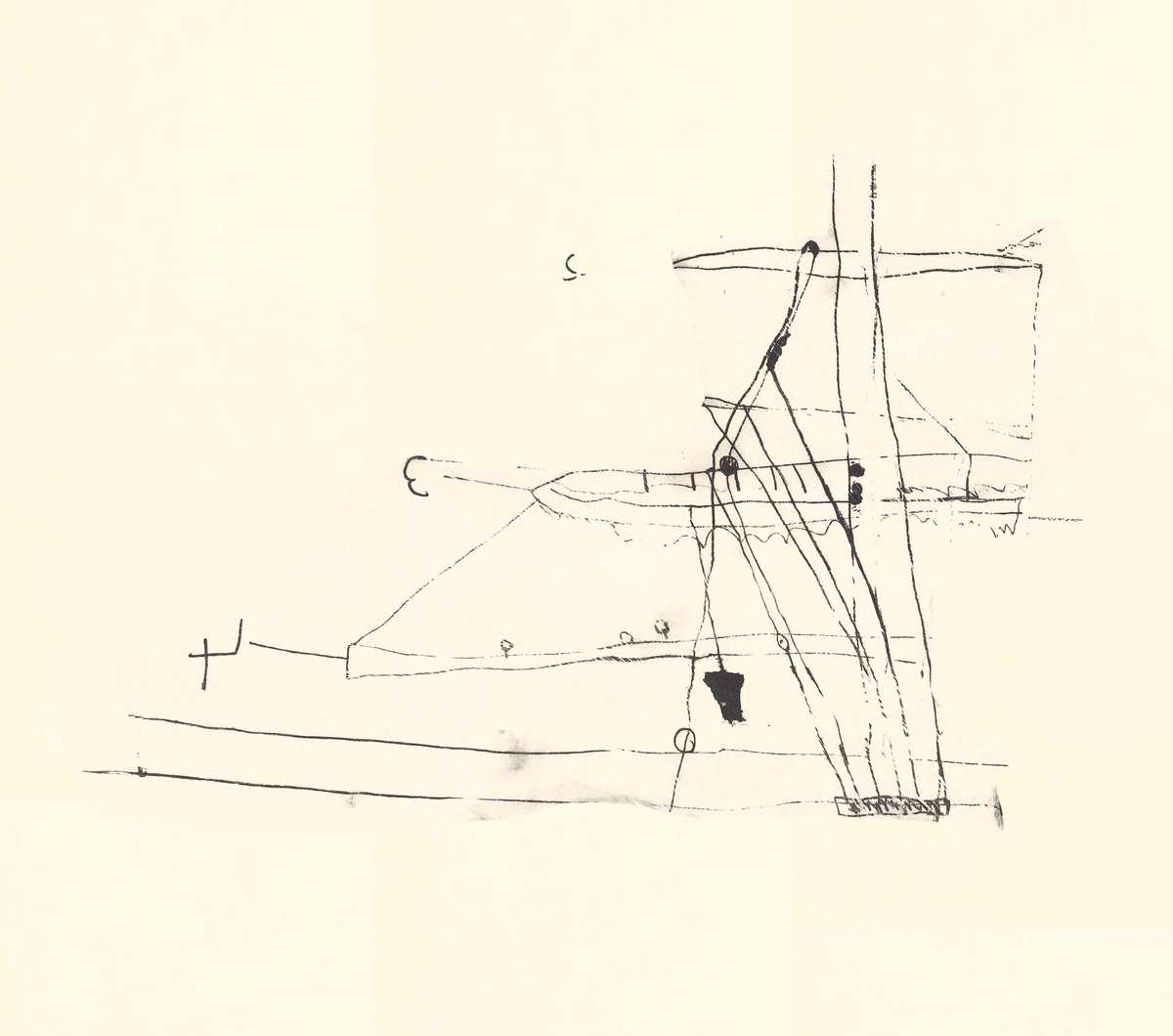
Digitally isolated drawing from Rauschenberg's Booster 1967
Behind the X-rayed torso is what has been referred to as ‘a roughed-in coordinate-plane diagram of indeterminate meaning’.18 This drawing, which is obscured by layers of montage, has reversed numerals that run down the left-hand side and its wobbly parallel lines give the impression of a ship’s rigging. Kenneth Tyler recalls that in preparation for the print, Rauschenberg had brought some ‘drawings [and] photos to the studio and we made impressions onto lithographic transfer paper. He would rub from the back side of the transfer paper with pencil onto [the lithography] stone’,19 a process that can be clearly seen in this image.
This enigmatic drawing is the only hand-drawn original work that has been transferred to the final print. The cascading numbers in this drawing bear some resemblance to the work of another of Rauschenberg’s partners: the artist Cy Twombly. Twombly, who was Rauschenberg’s partner from 1951 to 1953, had begun to incorporate cascading numbers into his paintings and drawings from the late 1950s onwards and this motif came to define Twombly’s work for over a decade. Perhaps this drawing in Booster was a gift from Twombly, or just a pastiche of his work created by Rauschenberg himself. This exchange could have been possible, as Twombly and Rauschenberg would begin to see each other again in the later part of the 1960s, with Twombly frequently visiting Rauschenberg’s studio from his home in Italy.20
A map
The veiled references to Rauschenberg’s relationships signal the momentous change in Rauschenberg’s life at the time. The artist reflected that in 1966, ‘everybody I knew was breaking up. Everything was falling apart. There was such an abundance of bad news’.21 He would admit to falling into a depression and felt burdened by a sense of responsibility for his friends who were going through similar experiences, saying, ‘I thought it was my bad influence causing everyone to break up and go crazy’.22 But Rauschenberg would seek out guidance to overcome this tumultuous year and we can view this in the work.
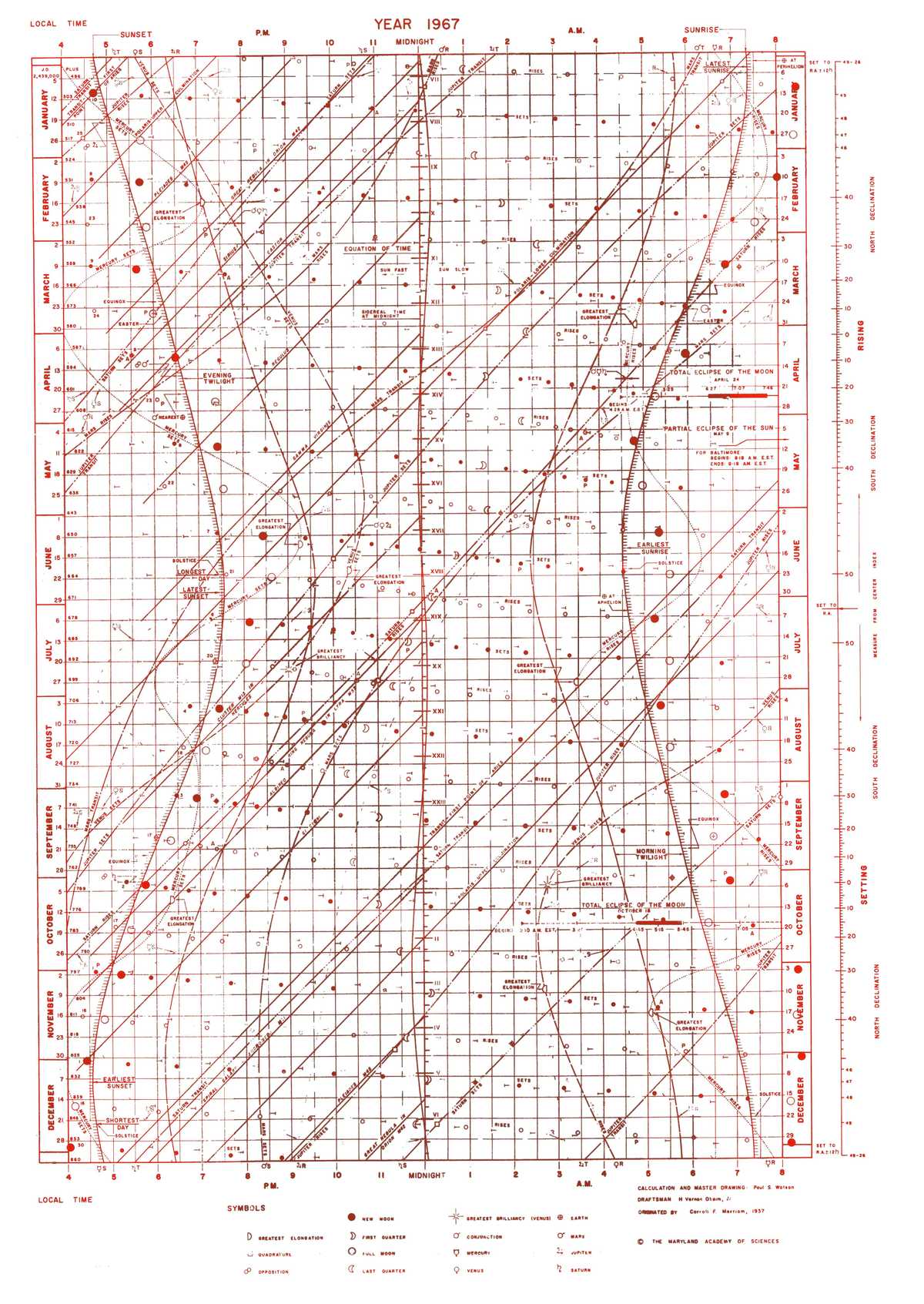
Maryland Academy of Sciences, Graphic timetable of the heavens 1967, digitally isolated from Rauschenberg’s Booster 1967
Over-printed on Booster’s X-ray is a chart of planetary movements and the phases of the moon for the year 1967 produced by the Maryland Academy of Sciences. This chart has a scientific purpose; however, for Rauschenberg, its appeal is not astronomical, but astrological: In 1966, Rauschenberg sought therapy for his mounting troubles, but with no ‘time or patience for psychoanalysis’ he instead saw an astrologer called Zoltan Mason, who was a specialist in Jean-Baptiste Morin’s system of horoscope reading.23 While many people are sceptical of astrology’s insights, Rauschenberg was convinced:
His assessment of my situation was right on … I found out that I had five of my most troublesome stars in conjunction with each other in my horoscope. The advice was to not ever go to the mountain[s] … and to head for the sun and the sea … so I started these various trips all down the East Coast.24
Robert Petersen, a printmaker at Gemini GEL, recalled that Rauschenberg took the astrologer’s advice seriously and would ‘get in his new car and leave Manhattan and take every road to the left that went to the water … He went every exit, all the way down to Florida. I guess he stopped in Captiva’.25 The year after finishing Booster, Rauschenberg made the decision that he would move to Captiva Island, Florida. His astrologer’s advice must have been weighing on the artist’s mind during the print’s production: this astronomical chart, extending across most of the print’s surface, is an insight into the astrological guidance based on the movement of celestial bodies, that Rauschenberg used to navigate his emotional predicament.
Crashes
Some of the most difficult-to-discern images in Booster occur in the top right and left of the artwork. The writer Robert Mattison has speculated that the image in the top right is a depiction of the Cape Canaveral space shuttle launch site on its side,26 reinforcing the idea that this work is concerned with the Cold War space race. This is incorrect: the image is a newspaper clipping of a fatal car accident: a car that plunged off the San Bernardino Freeway in Los Angeles.
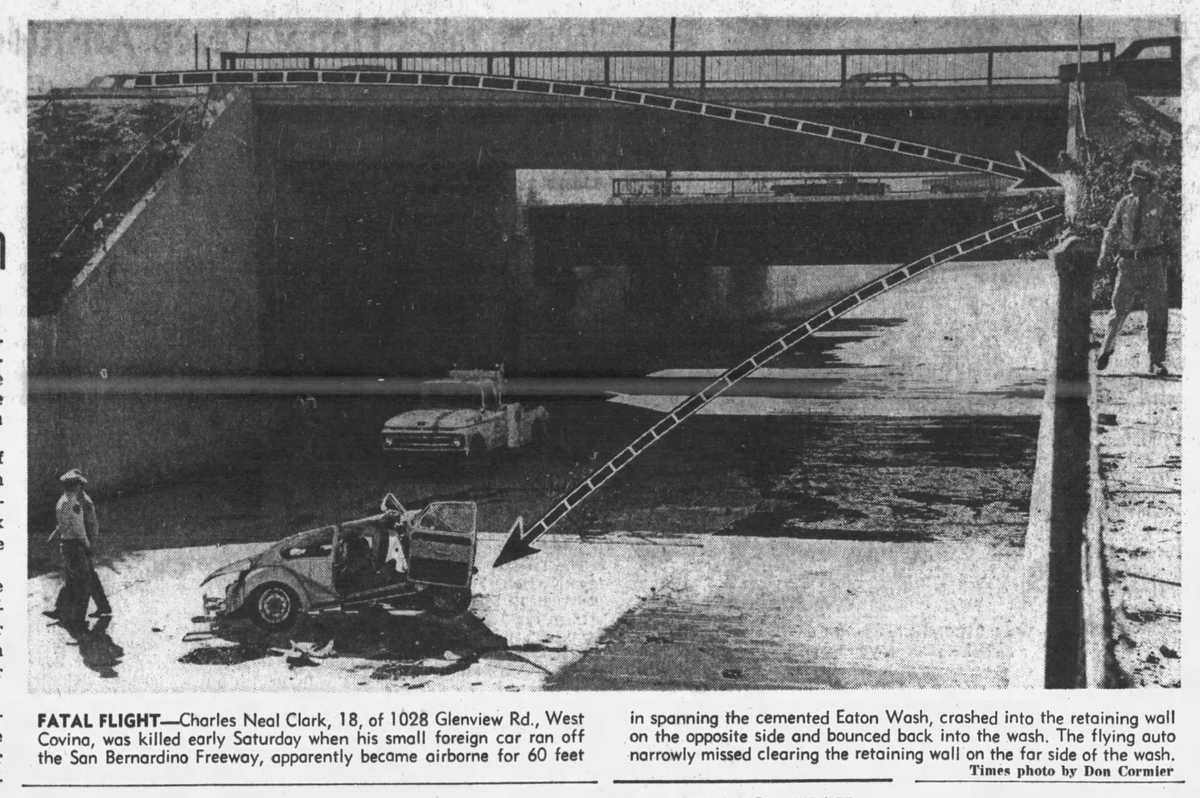
Newspaper clipping, Los Angeles Times, 5 February 1967. Image courtesy newspapers.com
The image on the left-hand side is also a car crash: the horrifying newspaper image of a sports car sheared in two on La Brea Avenue, also in Los Angeles. Just to the right of this image is a bird’s eye view of a gridlocked street in New York City. These car crash images are hard to see, but their repetition indicates the subject must have held some significance for the artist. They convey a sense of disaster, and correlate with Rauschenberg’s feeling that 1966 was a year of bad news. Their selection may have also been informed by the large amount of driving Rauschenberg was doing at the time as he explored America’s East Coast to escape the congestion of New York City.
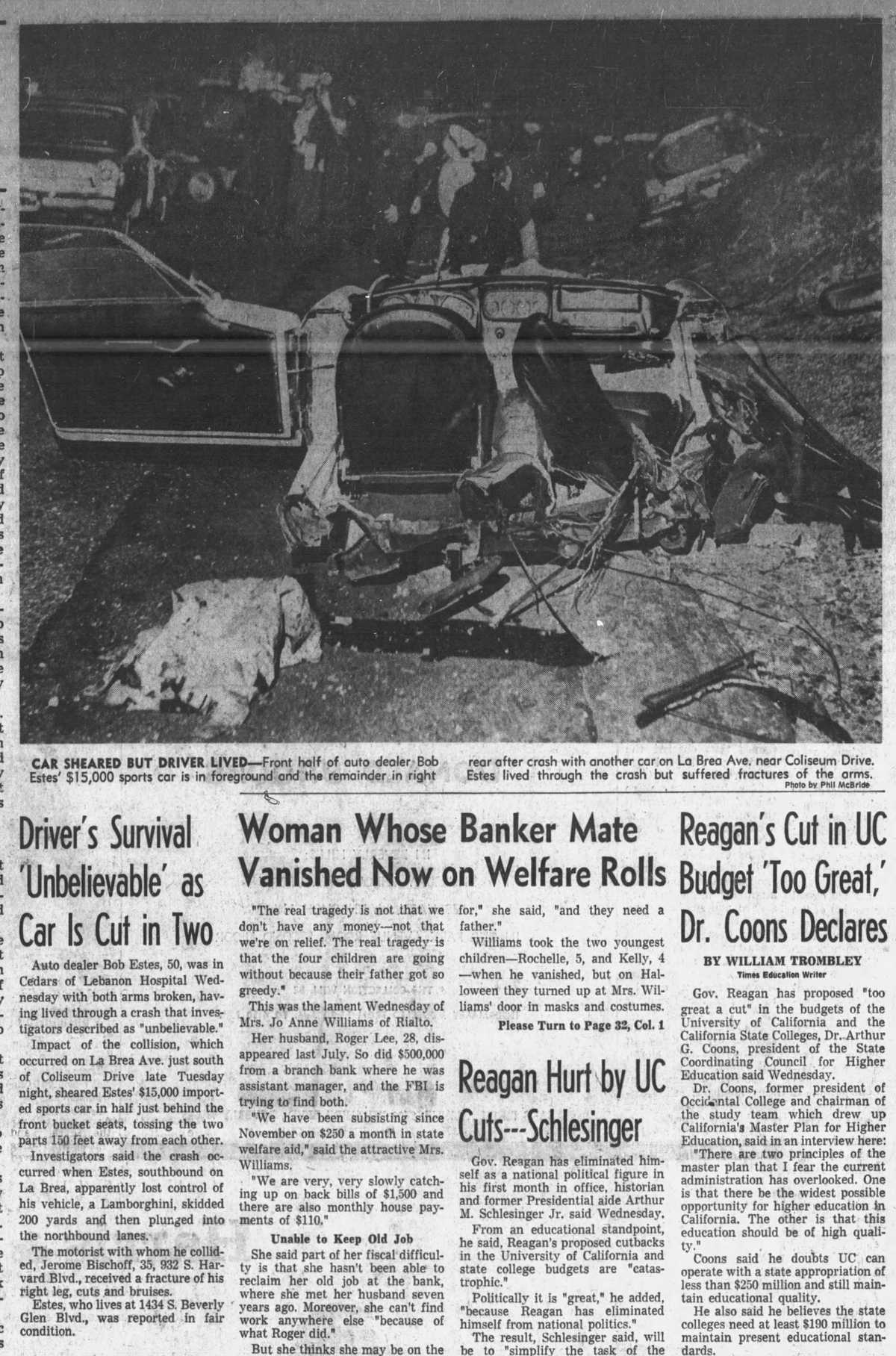
Newspaper clipping, Los Angeles Times, 9 February 1967. Image courtesy newspapers.com
The writer Jonathan Katz has speculated that debris, crumpled metal and car parts had previously signified the idea of relationship breakups in Rauschenberg’s work.27 He points to his Combine work Slow Fall 1961, produced by the artist in the aftermath of Rauschenberg’s split from Jasper Johns in 1961, in which a piece of metal debris is topped with a numberplate from Johns’s home state, South Carolina. We can only speculate as to whether these car crash images are similarly coded, but what is certain is that ‘bad news’ is an undercurrent within Booster.
Stress
The psychological weight of car crashes and traffic jams is reinforced when the hidden image behind the artist’s X-rayed legs is identified. To the untrained eye, this ambiguous industrial block could be just another ‘dumb’ image, but it is loaded with implications. Originally from an Alcoa aluminium advertisement, the object is a device for stress-testing metals and ‘testing weldments for susceptibility to stress-corrosion cracking’.28 The connotations of this image are clear: placed behind the body of the artist, it suggests an artist under immense pressure. An artist under stress, or about to crack.
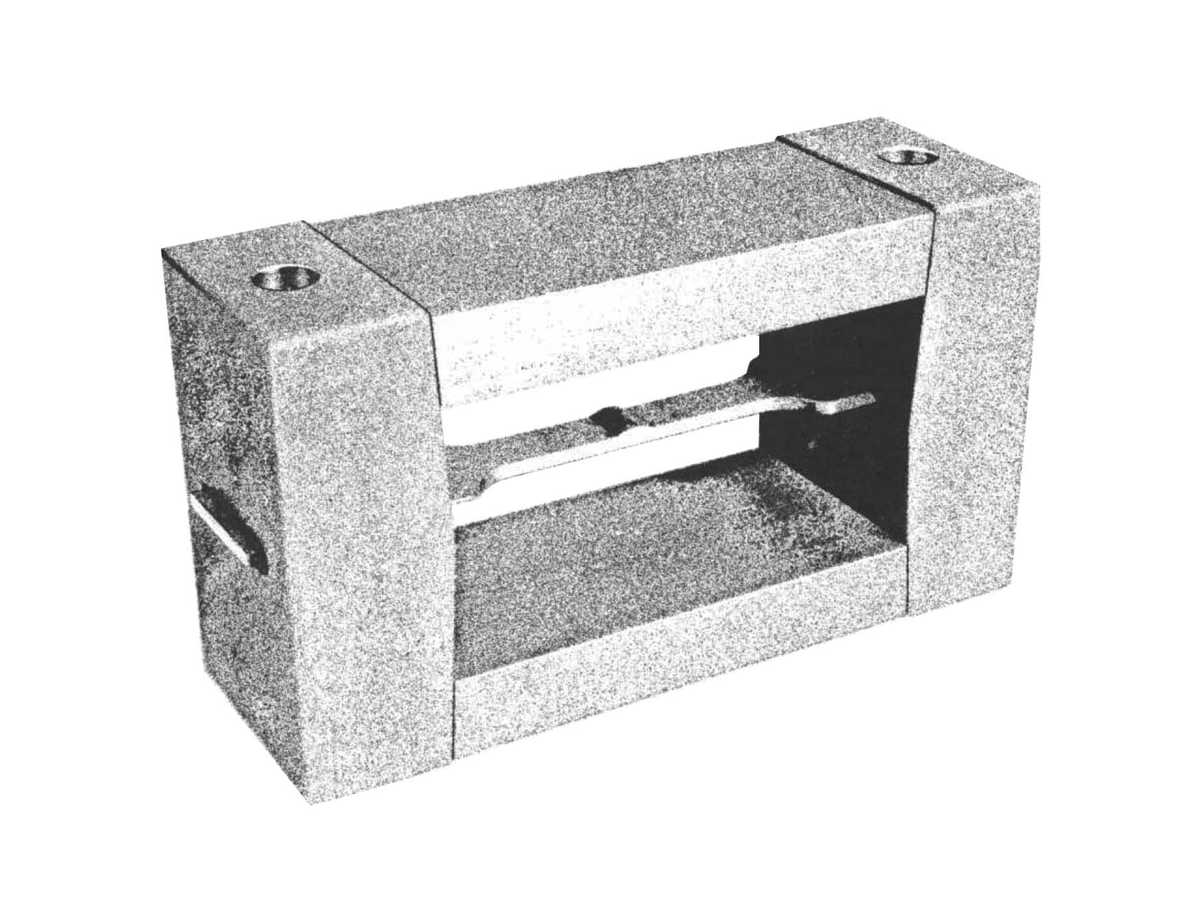
Image of a weight from an advertisement for Alcoa aluminium, Scientific American, December 1966
Rauschenberg’s Booster, his ‘self-portrait of inner man’, is a clearly autobiographical work of art. It records in a diaristic fashion the events of the artist’s life: his relationships, his feelings, and the unorthodox and otherworldly advice that he was following to change his life. Just as the X-ray allows us to look inside the body of a patient, this artwork allows us a glimpse into Rauschenberg’s life in 1967. Perhaps Rauschenberg’s statement that ‘only by accepting all that surrounds you can you be totally self-visualised’ can be applied to Booster: a work of art that was an act of self-reflection, acceptance and self-visualisation.29 The success of Booster in 1967 was instrumental in helping Rauschenberg purchase his first Captiva Island property in 1968,30 a place of solace that would reshape the artist’s life and work. Booster is hence a turning point both in printmaking history and in Rauschenberg’s life: A morale booster.
Header image: Robert Rauschenberg, Test stone #3 (detail) from Booster and 7 studies 1967, lithograph, printed in two colours, 56 x 72 cm, published by Gemini Graphic Editions Limited, Los Angeles. National Gallery of Australia, Kamberri/Canberra, purchased 1973 © Robert Rauschenberg / Copyright Agency, 2022
Notes
- — Rauschenberg oral history project: the reminiscences of Sidney B Felsen, conducted in collaboration with INCITE/Columbia Center for Oral History Research, Robert Rauschenberg Foundation Archives, 2014, p 6.
- — Mary Lynn Kotz, Rauschenberg: art and life, Harry N. Abrams, New York, 1990, p 153.
- — For example, see Robert S Mattison, Robert Rauschenberg: breaking boundaries, Yale University Press, New Haven, CT, 2003; Jason Weems, ‘Scanning Bob’s body: Rauschenberg’s “Booster”, science, and the techno-visual subject’, Bulletin of the Detroit Institute of Arts, vol 82, no 1–2); or Princeton University Art Museum, ‘Booster, 1967: interpretation’, viewed 9 September 2021, https://artmuseum.princeton.edu/collections/objects/51624.
- — Pat Gilmour, Kenneth Tyler: master printer and the American print renaissance, Australian National Gallery, Canberra, 1986, p 48.
- — Calvin Tomkins, Off the wall: a portrait of Robert Rauschenberg, Picador, New York, NY, 1980, p 240.
- — Jonathan D Katz, ‘The outness of Rauschenberg’s art’, The Gay and Lesbian Review, September–October 2008, viewed 14 September 2021, https://glreview.org/article/article-614/.
- — Karen Thomas, unpublished interview with Kenneth Tyler, master printer, 9 August 2012, Robert Rauschenberg Oral History Project, Robert Rauschenberg Foundation archives, p 2.
- — Ruth Fine, ‘Writing on rocks, rubbing on silk, layering on paper’, in Walter Hopps and Susan Davidson, Robert Rauschenberg: a retrospective, The Solomon R. Guggenheim Foundation, New York, 1997, p 384.
- — Robert Rauschenberg and Barbara Rose, Rauschenberg., Vintage Books, New York, NY, 1987, p 125.
- — Rauschenberg and Rose, p 20.
- — Rauschenberg and Rose, p 74.
- — Rauschenberg oral history project: the reminiscences of Sidney B Felsen, p 23.
- — Brian O’Doherty, ‘Rauschenberg II’, Object and idea: an art critic’s journal 1961–1967, Simon and Schuster, New York, 1967, p 116.
- — See Stephen Coppel, Catherine Daunt and Susan Tallman, The American dream: pop to the present, Thames and Hudson, London, in association with the British Museum, 2017, p 93.
- — Karen Thomas, p 3.
- — Kenneth Tyler in conversation with the author, 23 November 2018.
- — Edward A Foster, Robert Rauschenberg: prints 1948/1970, exhibition catalogue, Minneapolis Institute of Arts, Minneapolis, MN, 1970, p 40.
- — Weems, p 12.
- — Kenneth Tyler, email to the author, 24 May 2021.
- — Cy Twombly would visit Rauschenberg in his Captiva Island studio in November of 1968 to execute a series of collages based on Leonardo da Vinci’s anatomical studies. See Nicola Del Roscio, Cy Twombly drawings: Catalogue Raisonné Volume 1 1951–1955. Schirmer/Mosel, Gagosian Gallery, New York City, NY, 2011. p 183.
- — Rauschenberg and Rose, p 86.
- — Rauschenberg and Rose, p 87.
- — Paul Taylor, ‘Robert Rauschenberg’, Interview (New York), vol 20, no 12, December 1990, p 146.
- — Rauschenberg and Rose, p 86.
- — Rauschenberg oral history project: the reminiscences of Robert Petersen, conducted in collaboration with INCITE/Columbia Center for Oral History Research, Robert Rauschenberg Foundation Archives, 2015, p 290.
- — See Robert S Mattison, Robert Rauschenberg: breaking boundaries, Yale University Press, New Haven, CT, 2003. p 138.
- — Jonathan Katz, ‘The art of code: Jasper Johns and Robert Rauschenberg’, in Whitney Chadwick and Isabelle de Courtivron (eds), Significant others: creativity and intimate partnership, Thames and Hudson, London, 1996, p 206.
- — See Martin Gardner, ‘Mathematical Games: the multiple charms of Pascal’s triangle’, Scientific American, vol 215, no 6, December 1966, p 134.
- — Rauschenberg and Rose, p 72.
- — Kenneth Tyler, conversation with the author, 23 November 2018.
